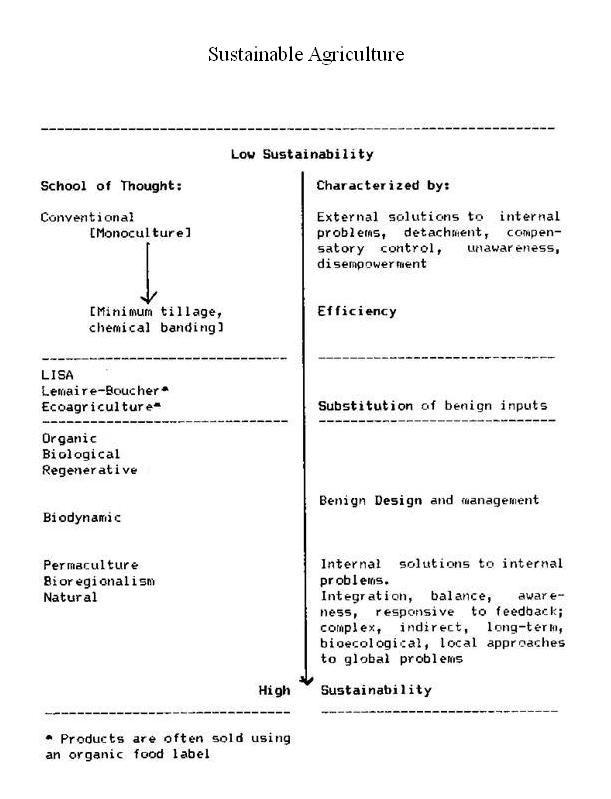Approaches of Sustainable Agriculture
Sustainable agriculture has been practiced for many decades and encompasses a tremendous number of different approaches described by many different names. To this point, most of these approaches have largely been limited to the substitution of environmentally
More significant advances can be expected, however, as a result of developments in the science and art of agro-ecosystem design and management. The names of the major schools of thought in sustainable agriculture are outlined in Figure 1, and are classified according to whether their operating principles are based on concepts of "efficiency", "substitution", or "redesign".
Many of the approaches in conventional agriculture (minimum tillage, chemical banding) would fall into the "efficiency" category. They demonstrate a reduction in resource use and associated negative environmental impact, and in many cases a reduction in input expenses for the farmer. They represent, however, only an initial step towards a truly sustainable system.
Efforts to substitute safe products and practices (botanical pesticides, biocontrol agents, imported manures, rock powders and mechanical weed control) are also gaining popularity. Despite the reduced negative environmental damage associated with them, they remain problematic. Botanical pesticides also kill beneficial organisms, the release of bio-controls does not address the question of why pest outbreaks occur dependence on imported fertilizer materials makes the system vulnerable to supply disruptions and excessive cultivation to control weeds is detrimental to the soil.
The systems that focus on redesign of the farm are the most sophisticated, generally the most environmentally and economically sustainable, over the long term. These farm systems recycle resources to the greatest extent possible, meaning that little is wasted, few pollutants are generated, and input costs are reduced substantially. For example, chicken and orchard operations have been successfully integrated. The manure is used as a fertilizer, the chickens eat pests that attack the fruit, the feed bill for the chickens is greatly reduced, and the eggs and/or meat can be consumed or sold. Three to seven year crop rotations can be designed that minimize tillage, use legumes and green manures to maintain soil fertility, prevent pest and disease outbreaks, and provide a diverse diet for livestock.
Pigs and goats can be used to renovate wooded lands in preparation for sheep pasture. The pigs and goats replace the petrochemical energy that would be consumed in machines, herbicides and fertilizers. All these practices involve redesigning the farm (as well as the institutional supports, which will be discussed later).
As in conventional agricultural systems, the success of sustainable approaches is very dependent on the skills and attitudes of the producers. The degree to which different models of such farms are sustainable is very variable, and is dependent on the physical resources of the farmer, and the degree deficiencies in support farm, the talents and commitment of the support available. The current from government, universities, and agricultural professionals means that farmers must often rely on their own talents and commitment.

|

